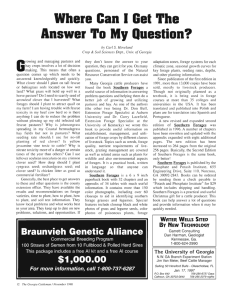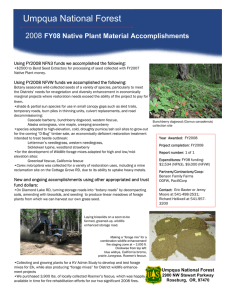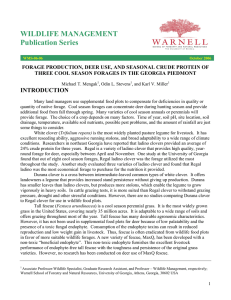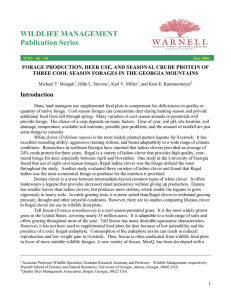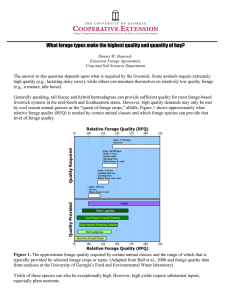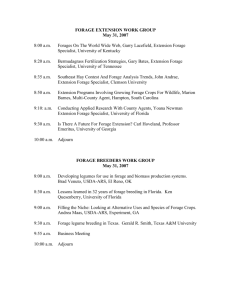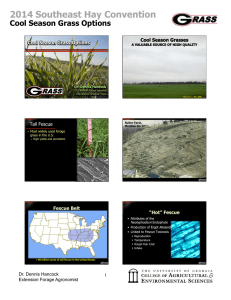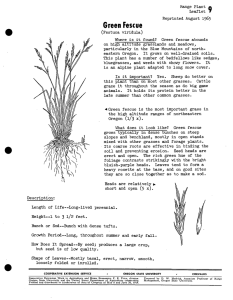WILDLIFE MANAGEMENT Publication Series
advertisement
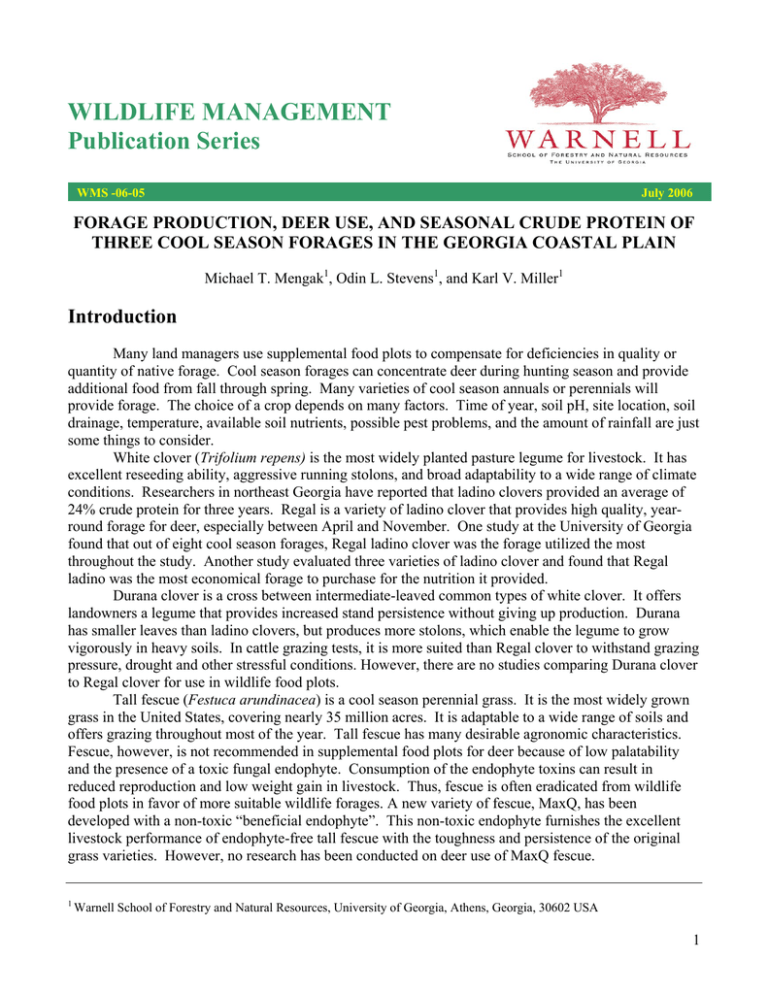
WILDLIFE MANAGEMENT Publication Series WMS -06-05 July 2006 FORAGE PRODUCTION, DEER USE, AND SEASONAL CRUDE PROTEIN OF THREE COOL SEASON FORAGES IN THE GEORGIA COASTAL PLAIN Michael T. Mengak1, Odin L. Stevens1, and Karl V. Miller1 Introduction Many land managers use supplemental food plots to compensate for deficiencies in quality or quantity of native forage. Cool season forages can concentrate deer during hunting season and provide additional food from fall through spring. Many varieties of cool season annuals or perennials will provide forage. The choice of a crop depends on many factors. Time of year, soil pH, site location, soil drainage, temperature, available soil nutrients, possible pest problems, and the amount of rainfall are just some things to consider. White clover (Trifolium repens) is the most widely planted pasture legume for livestock. It has excellent reseeding ability, aggressive running stolons, and broad adaptability to a wide range of climate conditions. Researchers in northeast Georgia have reported that ladino clovers provided an average of 24% crude protein for three years. Regal is a variety of ladino clover that provides high quality, yearround forage for deer, especially between April and November. One study at the University of Georgia found that out of eight cool season forages, Regal ladino clover was the forage utilized the most throughout the study. Another study evaluated three varieties of ladino clover and found that Regal ladino was the most economical forage to purchase for the nutrition it provided. Durana clover is a cross between intermediate-leaved common types of white clover. It offers landowners a legume that provides increased stand persistence without giving up production. Durana has smaller leaves than ladino clovers, but produces more stolons, which enable the legume to grow vigorously in heavy soils. In cattle grazing tests, it is more suited than Regal clover to withstand grazing pressure, drought and other stressful conditions. However, there are no studies comparing Durana clover to Regal clover for use in wildlife food plots. Tall fescue (Festuca arundinacea) is a cool season perennial grass. It is the most widely grown grass in the United States, covering nearly 35 million acres. It is adaptable to a wide range of soils and offers grazing throughout most of the year. Tall fescue has many desirable agronomic characteristics. Fescue, however, is not recommended in supplemental food plots for deer because of low palatability and the presence of a toxic fungal endophyte. Consumption of the endophyte toxins can result in reduced reproduction and low weight gain in livestock. Thus, fescue is often eradicated from wildlife food plots in favor of more suitable wildlife forages. A new variety of fescue, MaxQ, has been developed with a non-toxic “beneficial endophyte”. This non-toxic endophyte furnishes the excellent livestock performance of endophyte-free tall fescue with the toughness and persistence of the original grass varieties. However, no research has been conducted on deer use of MaxQ fescue. 1 Warnell School of Forestry and Natural Resources, University of Georgia, Athens, Georgia, 30602 USA 1 We studied forage production, use by white-tailed deer, and seasonal crude protein levels of MaxQ fescue, Regal ladino white clover, and Durana white clover. Our objective was to determine forage production and seasonal use by white-tailed deer of Regal ladino white clover, Durana white clover, and MaxQ fescue when planted alone and in combination. We assessed the adaptability of these forages to the Coastal Plain physiographic region of Georgia and evaluated the nutritional quality of each of these forages as measured by crude protein content. Study Area We conducted our study on private property in Tift County. This study site had well drained to excessively drained Norfolk loamy sand soils with very gentle slope. Georgia DNR estimated deer densities at 20 to 30 deer per mi2. Methods Prior to planting, we conducted soil tests and applied fertilizer and lime according to recommendations. We established one food plot on each site. Each food plot was 2.5 acres divided into five equal size subplots. We planted each subplot in pure Regal ladino clover (7.5 lb/ac), pure Durana clover (7.5 lb/ac), pure MaxQ fescue (17.5 lb/ac), a combination of MaxQ fescue and Regal ladino clover (7.5 lb/ac; 4.5 lb/ac), and a combination of MaxQ fescue and Durana clover (7.5 lb/ac; 4.5 lb/ac). Prior to planting, we mowed and harrowed each site to remove existing vegetation and minimize weed competition. We purchased all clover seed pre-inoculated with appropriate Rhizobium. For the purposes of this report, we will only discuss the pure plots and not confuse things with the combination clover-fescue plots for now. We randomly placed three exclosures on each subplot to prevent deer browsing. The exclosures were each about 1.5 feet in diameter and 4 feet tall and excluded deer from only a small area of the food plot. During each month of the study, we clipped all plants inside each exclosure to a uniform height of one inch from the ground. We also clipped an equal area outside of each exclosure to determine forage use. We placed the clipping samples into separate paper bags and labeled them for identification. We clipped each sub-plot about once every 30 days. After each sampling, we moved the exclosures to a new randomly chosen location within subplot. We dried and weighed all samples from each monthly clipping. We used the dry weight of forage to estimate production and use of each clover type based on standard mathematical formulas expanding clipped area to per acre values We estimated monthly production from the dry weight of forage inside the exclosure minus the dry weight of forage from outside the exclosure in the previous month. For example, there might be 1200 lb/ac of forage on the food plot in the month of September (based on the amount inside the exclosure). However, because the deer have access to all the forage outside the exclosure they might consume enough so that only 700 lb/ac of forage was present on the food plot in August. Then by using the formula to calculate production, we would subtract 700 lb/ac (the dry weight of forage from August) from 1200 lb/ac (the dry weight of forage from September) and come up with a 500 lb/ac of production. Results Production for both clovers ranged from a high of > 2500 lb/ac (2841 kg/ha) in April to lows of zero in mid-summer (Figure 1 and 2). Production for fescue ranged from a high of > 2700 lb/ac (3088 kg/ha) in April to a low of less than zero in the fall (Figure 3). Deer use of the Durana plots ranged from a high of 976 lb/ac (1095 kg/ha) in May to lows near zero in February and October. In our 2 study production exceeded use in April, May and June 2003. Use exceeded production from July 2003 until February 2004 (Figure 1). We observed a similar trend for Regal (Figure 2). The story was different, however, for MaxQ fescue. Production exceeded use from April 2003 through June 2003 and again for November 2003 to May 2004. From July to October 2003, use of the fescue exceeded production although both were very low (Figure 3). Production Durana - Coastal Plain Utilization 2250.0 Forage Biomass (lb/ac) 2000.0 1750.0 1500.0 1250.0 1000.0 750.0 500.0 250.0 0.0 MAR APR MAY JUN JUL AUG SEP OCT NOV DEC JAN FEB MAR APR MAY Month Figure 1. Forage biomass (lb/ac) of Durana clover on food plots in the Coastal Plain physiographic province of South Georgia from April 2003 to May 2004. The forage quality of Durana and Regal, as measured by protein content, was consistently higher than MaxQ fescue throughout the study (Figure 4). Both clovers averaged over 20.0 % crude protein while MaxQ fescue ranged from 9.0 to 18.0 % over the study period (Figure 4). Discussion We mowed the study plots in August 2003 and fertilized during September 2003 and March 2004 soon after data were collected for the month. Overall production was somewhat consistent among forages. 3 Production Regal - Coastal Plain Utilization Forage B iomass (lb/ac) 2250.0 2000.0 1750.0 1500.0 1250.0 1000.0 750.0 500.0 250.0 0.0 MAR APR MAY JUN JUL AUG SEP OCT NOV DEC JAN FEB MAR APR MAY Month Figure 2. Forage biomass (lb/ac) of Regal ladino clover on food plots in the Coastal Plain physiographic province of South Georgia from April 2003 to May 2004. Production MaxQ - Coastal Plain Utilization 2250.0 Forage Biomass (lb/ac) 2000.0 1750.0 1500.0 1250.0 1000.0 750.0 500.0 250.0 0.0 M AR APR M AY JUN JUL AUG SEP OCT NOV DEC JAN FEB M AR APR M AY Month Figure 3. Forage biomass (lb/ac) of MaxQ fescue on food plots in the Coastal Plain physiographic province of South Georgia April 2003 to May 2004. 4 Durana Clover Regal Ladino Clover MaxQ Fescue Crude Protein Values 35.0 Crude Protein Percent 30.0 25.0 20.0 15.0 10.0 5.0 0.0 JAN FEB MAR APR MAY JUN JUL AUG SEP OCT NOV DEC Month Figure 4. Monthly average crude protein values (percent) for two varieties of white clover and MaxQ tall fescue planted in food plots in the Coastal Plain physiographic province of Georgia from April 2003 to May 2004. Deer generally used the two clovers similarly but used MaxQ fescue much less. In addition to production and use, we used crude protein as an indicator of forage quality. Crude protein is an important consideration when determining what forages to plant for supplemental nutrition. The forage quality of Durana and Regal was similar during our study. Both provided over 20% crude protein throughout the year except in the months of April and May. MaxQ fescue had the lowest average crude protein of all forages tested in our study. This may explain why the clovers were preferred over MaxQ fescue during all sampling periods. MaxQ fescue tested between 9 and 18% crude protein all 12 months. For that reason, we suggest not planting MaxQ fescue as a food plot crop but rather use the high quality, highly productive clovers. Conclusion The ideal forage for deer would be one that produces year-round, high-quality forage that is preferred by deer. Many high-quality forages do not tolerate extreme weather conditions compared to low-quality forages. However, perennial white clovers, such as Durana or Regal ladino, appear to provide a satisfactory combination of high nutrition and tolerance of harsh conditions. Although we only measured production for one year, based on past cattle grazing studies at University of Georgia experiment stations, we predict that during the next few growing seasons, Durana will maintain more complete stand coverage than Regal because of Durana’s tolerance to heavy grazing, extreme weather conditions, and it’s inherently competitive nature due to higher stolon density. We conclude Durana will provide high quality perennial forage for more than two years. MaxQ fescue has the potential to provide an enormous amount of forage and it grew well in our study area. However, given the relatively low use and low crude protein levels, MaxQ is inferior to 5 either of the clovers for planting in food plots. Although MaxQ fescue could be considered for planting in some situations, such as highly erodable sties, the high productivity, preferred use, high nutrient content, and tolerance to grazing of the two varieties of clover clearly make them the plantings of choice Acknowledgments The Daniel B. Warnell School of Forestry and Natural Resources supplied a graduate research assistantship (Stephens) and Pennington Seed provided seed and fertilizer. We gratefully acknowledge the support of the Stephens family for allowing us do use their farm for this study. Warnell School of Forestry and Natural Resources Athens, Georgia 30602-2152 Telephone 706.542.2686 Fax 706.542.8356 In compliance with federal law, including the provisions of Title IX of the Education Amendments of 1972, Title VI of the Civil Rights Act of 1964, Sections 503 and 504 of the Rehabilitation Act of 1973, and the Americans with Disabilities Act of 1990, the University of Georgia does not discriminate on the basis of race, sex, religion, color, national or ethnic origin, age, disability, or military service in its administration of educational policies, programs, or activities; its admissions policies; scholarship and loan programs; athletic or other University-administered programs; or employment.. In addition, the University does not discriminate on the basis of sexual orientation consistent with the University non-discrimination policy.. Inquiries or complaints should be directed to the director of the Equal Opportunity Office, Peabody Hall, 290 South Jackson Street, University of Georgia, Athens, GA 30602.Telephone 706-542-7912 (V/TDD).Fax 706-542-2822 6
